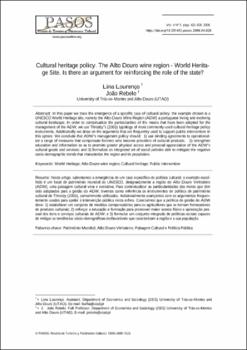Cultural heritage policy. The Alto Douro wine region - World Heritage Site. Is there an argument for reinforcing the role of the state?
Fecha
2006Resumen
In this paper we trace the emergence of a specific case of cultural policy: the example chosen is a
UNESCO World Heritage site, namely the Alto Douro Wine Region (ADW) a portuguese living and evolving
cultural landscape. In order to contextualize the particularities of the means that have been adopted for the
management of the ADW, we use Throsby’s (2001) typology of most commonly-used cultural heritage policy
instruments. Additionally we draw on the arguments that are frequently used to support public intervention in
this sphere. We conclude that ADW’s management policy should: 1) use binding agreements to operationalize
a range of measures that compensate farmers who become providers of cultural products; 2) strengthen
education and information so as to promote greater physical access and personal appreciation of the ADW’s
cultural goods and services; and 3) formulate an integrated set of social policies able to mitigate the negative
socio-demographic trends that characterize the region and its population. Neste artigo, salientamos a emergência de um caso específico de política cultural: o exemplo escolhido
é um local de património mundial da UNESCO, designadamente a região do Alto Douro Vinhateiro
(ADW), uma paisagem cultural viva e evolutiva. Para contextualizar as particularidades dos meios que têm
sido adoptados para a gestão do ADW, tivemos como referência os instrumentos de política de património
cultural de Throsby (2001), comummente utilizados. Adicionalmente avançámos com os argumentos frequentemente
usados para apelar à intervenção pública nesta esfera. Concluímos que a política de gestão do ADW
deve: 1) estabelecer um conjunto de medidas compensatórias para os agricultores que se tornam fornecedores
de produtos culturais; 2) reforçar a educação e formação para promover maior acesso físico e apreciação pessoal
dos bens e serviços culturais do ADW; e 3) formular um conjunto integrado de políticas sociais capazes
de mitigar as tendências sócio-demográficas desfavoráveis que caracterizam a região e a sua população.





